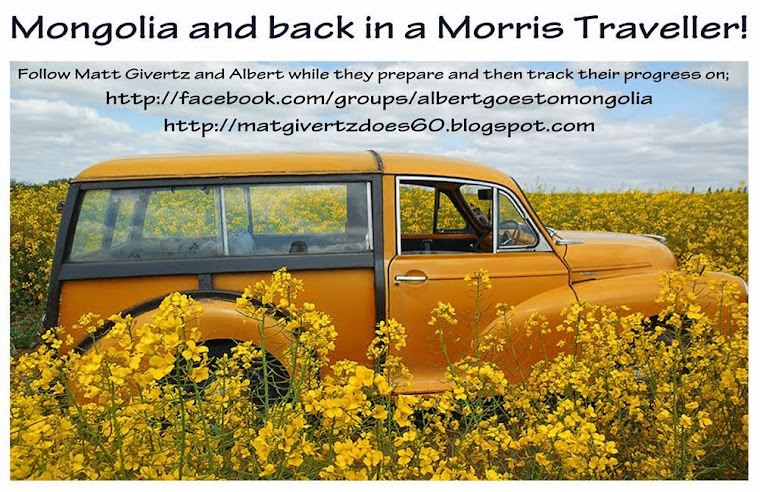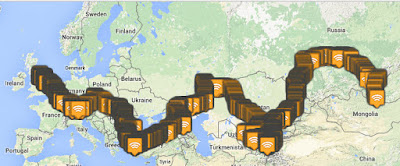So, dear reader, our adventure is at an end and it is now time to look at what was good, not so good and what lessons were learnt from my first overland trip. As you may recall I had intended to do a couple of shake down trips before the big one but this was not to be and so after a journey of over 20,000 miles through 23 countries I pretty much have been tested in some cases to destruction so read on to find out more.
What was good
The original design (seen below) was to transform a Morris Minor Traveller into an overland vehicle and was supposed to give me both a long range tank and sufficient storage for spares, camping equipment and food and water as needed to allow us to be self-sufficient in remote areas such as the deserts of Kazakhstan and the Pamir Highway. To the extent that I have now completed a 20,000 mile trip I can confidently state that the design worked and I am now officially an overland vehicle!
 |
| Conceptual Design |
The final design wasn't quite as planned but still had a long range tank
(around 35 gallons) and three tiers of storage. The lower tier which
consists of the original petrol tank was used for parts storage and a
spare tyre as well as a leisure battery, toolkits and 5l of oil. The
second tier was used for the second spare and a 20L Jerry can of fuel.
Finally the third tier was used for everything else. A pull out table
positioned below the top tier of storage gave somewhere to make tea and
even cook Matt and Sarah's supper.
 |
| Three tiers of storage and long-range tank |
 |
| Loaded |
Matt and Sarah were going to be spending a lot of time driving so comfortable seats were important. Saab 9000 leather seats made sure that they didn't get too sticky in the hot countries and were comfortable for long periods. That said, Sarah did feel the need for a cushion :)
 |
| Saab 900 Seats |
Considering that there was no shakedown trips my overall handling of the various types of driving conditions was excellent (even if I do say so myself). The original 4.55 differential combined with my 1275cc engine and Midget gearbox allowed for excellent hill climbing although flat line speed was limited to around 50mph.
The second battery supplying power to the coolbox and Matt and Sarah's USB gadgets as well as the GPS speedo and dashcam meant that there was plenty of power and that the main electrics were powered through the main battery which was protected against inadvertent draining. A voltage selective relay made sure that both batteries were adequately charged with the main battery taking precedence.
The sump guard was fantastic and ultimately saved the day by protecting the sump from failure following a huge hit on the Pamir Highway. Oscillations created by the rough terrain resulted in the front-end coming down heavily on a rock which dislodged the steering column. The sump guard took the majority of the shock however the sump was still damaged. Without the sump guard it would have totally been game over :(
 |
| Sump damage reduced through sump guard |
Having the storage I had allowed me to stock up on spares such as hoses, inner tubes, alternator, clutch, fuel pump, half shafts, gaskets and other bits and pieces we thought we may need some of which we did.
 |
| Inflatable jack |
Although there was plenty of storage space was at a premium so we were loaned an inflatable jack which proved invaluable whilst on the Pamir Highway where uneven ground would have made use of a bottle jack or trolley jack very difficult.
What was not so good
Whilst the Saab seats were comfortable the bulkhead prevented the seats being moved back further which caused Sarah some discomfort as she really needed some more leg room. Also the interior light was ineffective.
 |
| Limited seat adjustment |
Generally I handled poor roads and the rough terrain of the Pamir Highway very well however there was some damage caused through excessive vibrations. The rear of the engine compartment and the tie bar support both suffered fractures which were temporarily fixed en-route.
 |
| Engine compartment support fractures |
 |
| Tie bar fractures |
The other major issue experienced was the failure of the differential. This was probably caused by the gasket failing and loss of all the diff oil. We knew that there was an issue with nuts and boltss working loose and the differential drain plug was also affected so the diff oil level was being watched and we topped this up in Osh however we think that the replacement of the rear universal joint disturbed the diff and the already damaged gasket failed resulting in the failure of the near-side half shaft and the crown wheel shaft failing probably through over-heating.
 |
| Diff failure |
 |
| Half-shaft failure |
Nuts and bolts loosened due to the poor road conditions and excessive vibrations. I lost some trim and a number of retaining bolts but nothing major just disruptive. Losing a bolt from the starter motor in Turkey proved to be the most disruptive of these issues. Despite having plenty of spares there were some issues where we needed parts to be shipped out from the UK in particular a rear oil seal, brake light switch, solenoid, starter motor and universal joints.
Whilst the inflatable jack was fantastic on uneven ground, and where clearances wouldn't allow for the use of a bottle or trolley jack, it was very hard to use on good tarmac roads. We found that I tended to move due to the camber on the road once a wheel was removed which made changing the wheel very difficult and on a couple of occasions Matt and Sarah needed to co-opt assistance to counter my tendency for the jack to push me towards the camber.
During the adventure the following repairs needed to be carried out
- Front universal joint - Bulgaria
- Replacement starter motor bolt - Turkey
- Throttle cable adjusted - Tajikistan
- Steering column re-seated - Tajikistan
- Wheels straightened - Tajikistan
- Fuel pump replaced - Kyrkystan
- Carburetor cleaned - Kyrkystan
- Brake light switch replaced - Kazahkstan
- Rear universal joint - Russia
- Front and Rear oil seals - Russia
- Clutch and Starter motor - Russia
- Lada rear axle fitted (to address diff failure) - Russia
There was a persistent oil leak which meant daily (or pretty much daily) topping up of engine oil. This was found to actually be due to a small split in the sump caused by the 'big hit' on the Pamir. Also the dip stick tube was dislodged and so was another area where small amounts of oil were lost. We had around twelve flat tyres using up a total of three inner tubes.
Whilst not so good I don't think it was too bad given the distance travelled and the conditions of the roads in some of the countries like Kazakhstan, Uzbekistan and the Pamir Highway.
Lessons learnt
Whilst the not so good wasn't that bad there were still some lessons learnt from this adventure which I'm going to try and incorporate into the next re-iteration of the design to make me the ultimate personal overland vehicle.
There are a number of areas that I need to address which can be broken down into a number of areas
Comfort - The main problem was lack of adjustment caused by the bulkhead position. I need to look at this in order that more leg room can be got through seat adjustment. Given the way the bulkhead is attached this may not be so straight forward but a change is needed to this element of the design.
Storage - Generally this was OK but the lack of compartments meant that everything was piled on top of each other. This meant that in some cases 'stuff' had to be emptied to get to the item needed. This was most obvious when we needed to change a wheel. Any future design of the interior is going to need some compartments specifically for items such as tools, larger spares, jack etc.
Spares - Whilst I had some large spare items such as a clutch and alternator there were some smaller items that I should have taken such as the universal joints, oil seals, solenoid etc. By addressing the storage it should be possible to make sure that I can take all the possible spares required. Many spares are quite small and whilst I hope they will not be needed there is no real reason not to take them.
Performance - As a consequence of the differential failure it was clear that I need to look at my running gear in a bit more detail. While the original 4.55 diff with my original wheels gave me good uphill performance under load the replacement 3.9 Lada diff with 13" wheels was rubbish going uphill but certainly improved my speed on level tarmac roads. As a consequence I need to find a good median that will give me good performance uphill as well as on the flat when under load.
The suspension also worked well however the front suspension suffered from the bouncing created by oscillation on off-road conditions and so needs looking into to see what can be done to reduce oscillation and the effects of this.
Me - The main problems I experienced were related to my construction. There are areas where my chassis needs strengthening in particular the areas that split. Also nuts and bolts shaking lose through vibrations would suggest I need nyloc nuts and to use something like loctite on studs and bolts to reduce the effect vibration has on these.
The main lesson learnt is that a Morris Minor Traveller can be successfully modified to act as a personal overland vehicle which can cope with varying road conditions and that whilst there may be some additional modifications needed as a result of this adventure I can honestly say an overland traveller has been born!!












































































